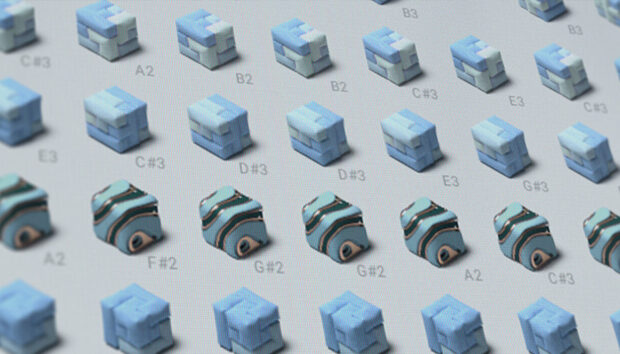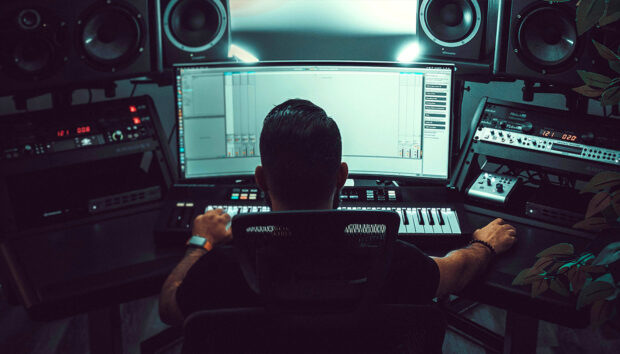From his base in the small English city of Norwich, Sully has become known as one of the most formidable talents in modern jungle. Originally emerging from the hazy territory between dark garage, dubstep and grime, Jack Stevens tightened his focus to breakbeats just as UK dancefloors pivoted back to jungle in the last decade. His releases on underground UK labels like Keysound, Astrophonica and Black Acre have continually raised the bar for UK bass music, blending the madcap energy of vintage junglism with a modern ear for haunting sound design.
Sully’s sketch demonstrates his talent for hearing drum patterns as melody lines, pitching individual drum hits and blending multiple instruments into a dazzling rhythm symphony. Opening with the metallic clang of oil drums, he weaves in a battery of tactile percussion and glassy jangles to create a deeply spooky and dissociative take on drum and bass.
Listen to the sketch then read on to learn how it was made. You can also grab all of the stems below, along with Sully’s Renoise project file.
NI products used: DECODED FORMS, REAKTOR 6, KONTAKT 6, WEST AFRICA, FM8, RAZOR.
Tell us about how you made the track – where’d those drums come from?
The first thing I went looking for was a breakbeat. Good ones are hard to come by so I usually find it easiest to start there and work around it. Fortunately there are a few corkers in the Decoded Forms pack. I grabbed one called Ant 1, which to my ears sounds like a punchy re-do of the Kool and The Gang ‘N.T.’ break. That got sliced up into individual hits and sequenced, then I loaded up a kick called Proto 2 from the same pack and looped a wave cycle in the tail to make a nice thumpy bass: BEOOOOOW.
Next port of call was an old favorite of mine, Reaktor’s Steampipe 2. I struggle to make a sound I don’t like with that synth, it’s a proper gem. I was aiming to make the most out of the preset sounds so I did a bit of bank-hopping and had a little jam with the Oil Drum preset. With a tweak to tighten up the decay it almost sounded like part of the snare from the drum break, so the tone was set.
The other main element is a running djembe pattern from the West Africa library in Kontakt, which livens up the rhythm section. Then there are some atmospheric licks that float in and out, namely the 08-15 pad from FM8 and the Kontakt Rhodes, both going through the Reaktors huge Space Master reverb.
Halfway through I bring in a new bass made with a couple of FM8 operators and a mad jangly thing in Razor called Metalize. The oil drum pattern switches up and the djembe drops out for a bit of a tangent, rolling out for the rest of the sketch. To round it off I loaded the break into Kontakt and used the timestretch to lock the tempo and make it a ringy, pitched percussion thing. That was used for the intro and by that point I reckoned I had the elements of a full track sketched out.
What does sketching mean to you?
Sketching is the fun bit. It’s getting all the toys out (or maybe a select few) and seeing what the possibilities are. If you manage to find the fun there’s usually something worth pursuing there.
What did you want to achieve with your sketch?
Same as always – create a mood with the tools at hand.
What’s your favorite element of the sketch?
Probably the Steampipe patch based on the Oil Drum preset because it meshes with the drum break so well. Synthesized elements don’t always gel with drum loops that sound like they were recorded in the ‘60s, so when I stumble on one of those winning combinations it’s a buzz. And it’s just a great sound, morphing between woodblock percussion and flute depending on how it’s played. I bloody love this synth.
How do you go from a sketch to a finished track?
With great perseverance. I find this by far the hardest part of writing so it’s usually a case of throwing things at the wall until something sticks. I’ve played in bands since my teens so I look at it from that perspective – you have your instruments, then you need sections. I’m not big on gradual evolving automations or whatever, it’s just developing the ideas with the notes I put down. So I keep putting down more notes until there’s enough solid ideas to start arranging them together. When I get there I’ll start structuring them and that’s when the full form starts to take shape.
What’s the best production advice you’ve ever been given?
Don’t make direct comparisons. It’s an easy hole to fall into and it can be helpful to reference technical stuff, like EQ or leveling, but by and large it’s the quickest route to paralyzing self doubt.
What are some of your favorite online learning resources and why?
I like the corners of the internet where people obsess over certain sounds, source them and reverse engineer them. Whosampled.com is widely known, but blimey, there’s some deep knowledge on there. Tracing the lineage of samples is fascinating, it’s like mapping the DNA of a culture. If you want to go deeper still, the breakbeat subforum on rolldabeats.com goes into the minutiae of early drum and bass breaks to an insane level. It just stops short of disclosing how many cups of tea were made during the session when a particular sample disc was passed from one producer to the next.
Sully’s latest release is a remix of Last Japan’s “Exhale” ft. Killa P. Listen to it here.
Words: Chal Ravens
Photo: Lerz Moore
















